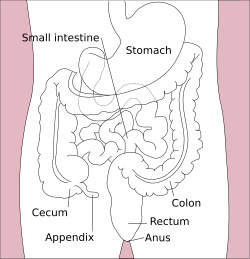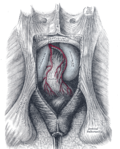Human anus
| Human anus | |
|---|---|
Superficial inguinal lymph nodes | |
| Identifiers | |
| Latin | anus |
| MeSH | D001002 |
| TA98 | A05.7.05.013 |
| TA2 | 3022 |
| FMA | 15711 |
| Anatomical terminology] | |
 |
| Major parts of the |
| Gastrointestinal tract |
|---|
In humans, the anus (pl.: anuses or ani; from Latin ānus, "ring", "circle")[1][2] is the external opening of the rectum located inside the intergluteal cleft. Two sphincters control the exit of feces from the body during an act of defecation, which is the primary function of the anus. These are the internal anal sphincter and the external anal sphincter, which are circular muscles that normally maintain constriction of the orifice and which relax as required by normal physiological functioning. The inner sphincter is involuntary and the outer is voluntary. Above the anus is the perineum, which is also located beneath the vulva or scrotum.
In part owing to its exposure to feces, a number of medical conditions may affect the anus, such as
With
Structure

The anus is the final part of the gastrointestinal tract, and directly continues from the rectum, passing through the pelvic floor. The top and bottom of the anus are surrounded by the internal and external anal sphincters, two muscular rings which control defecation.[6]: 397 The anus is surrounded in its length by folds called anal valves, which converge at a line known as the pectinate line. This represents the point of transition between the hindgut and the ectoderm in the embryo. Below this point, the mucosa of the internal anus becomes skin.[6] : 397 The pectinate line is also the division between the internal and external anus.
The anus receives blood from the
Microanatomy
The pseudostratified columnar epithelium of the gastrointestinal tract transitions to stratified squamous epithelium at the pectinate line. The stratified squamous epithelium gradually accumulates sebaceous and apocrine glands.[8]: 285
Development
During
Function
Defecation
Intra-rectal pressure builds as the rectum fills with feces, pushing the feces against the walls of the anal canal. Contractions of abdominal and pelvic floor muscles can create intra-abdominal pressure, which further increases intra-rectal pressure. The internal anal sphincter (an involuntary muscle) responds to the pressure by relaxing, thus allowing the feces to enter the canal. The rectum shortens as feces are pushed into the anal canal and peristaltic waves push the feces out of the rectum. Relaxation of the internal and external anal sphincters allows the feces to exit from the anus, finally, as the levator ani muscles pull the anus up over the exiting feces.
Clinical significance
Other
Infections
Additional
- Sexually transmitted infections
- Anal warts, also called anal condyloma
Cancer
Itching, incontinence and constipation
Itchiness, called
Damage or injury to the anal sphincter (
-
A grade IV hemorrhoid protrudes out of the anus.
Society and culture
Sexuality

The anus has a relatively high concentration of nerve endings and can be an erogenous zone, which can make anal intercourse pleasurable if performed properly. The pudendal nerve that branches to supply the external anal sphincter also branches to the dorsal nerve of the clitoris and the dorsal nerve of the penis.[14]
In addition to nerve endings, pleasure from anal intercourse may be aided by the close proximity between the anus and the
Anal intercourse is sometimes referred to as sodomy or buggery, and is considered taboo in a number of legal systems. It has been, and in some jurisdictions continues to be, a crime carrying severe punishment.[5]
Hygiene
To prevent diseases of the anus[citation needed] and to promote general hygiene, humans often clean the exterior of the anus after emptying the bowels. A rinse with water from a bidet or a wipe with toilet paper is often used for this purpose, though anal cleansing practices vary greatly between cultures.
Cosmetics
Shaving, trimming,
A true anal piercing is rare because it may interfere with the function of the anus and cause infections. Surface piercings of the perineum are easier to care for and much more common.
Some people have their anuses tattooed.
Slang
The anus has many slang terms including asshole, butthole (and their respective British equivalents arsehole, bumhole), cornhole, and bunghole.
Additional images
-
Muscles of the male perineum
-
Muscles of the female perineum
-
The posterior aspect of the rectum and anus exposed by removing the lower part of the sacrum and the coccyx
-
Raphe perinealisof a human female. The raphe perinealis is a fibrous plate of tissue that extends from the anus to the scrotum or vulva.
See also
- Anal bleaching
- Anal stage (Freudian psychosexual stage)
- Anococcygeal nerve
- Anorectal disorder
- Buttocks
- Cloaca
- Coccydynia
- Coccyx
- Flatulence
References
- ^ Martim de Albuquerque (1873). Notes and Queries. Original from the University of Michigan: Oxford University Press. p. 119.
- ^ O'Reilly, Edward; O'Donovan, John (1864). An Irish-English Dictionary. Original from Oxford University: J. Duffy. p. 7.
- PMID 19598294.
- ^ "Anal Cancer". The Lecturio Medical Concept Library. Retrieved 24 July 2021.
- ^ a b c d "Anal Sex, defined". Discovery.com. Archived from the original on June 13, 2002. Retrieved July 23, 2013.
- ^ ISBN 978-0-8089-2306-0.
- ISBN 9781451119459.
- ^ Young, Barbara; Lowe, James S.; Stevens, Alan; Heath, John W. (2006). Wheater's functional histology: a text and colour atlas (5th ed.). Churchill Livingstone, Elsevier.
- ^ ISBN 978-0-7020-7028-0.
- ^ "Anorectal Abscess". Johns Hopkins Medicine. Archived from the original on 10 August 2021. Retrieved 10 August 2021.
- ^ Ansorge, R; Robinson, J (15 September 2019). "Anal Abscess". WebMD. Retrieved 10 August 2021.
- ^ "Anal Cancer". The Lecturio Medical Concept Library. Retrieved 10 August 2021.
- ^ "Megacolon". The Lecturio Medical Concept Library. Retrieved 10 August 2021.
- ^ ISBN 978-0-8018-9396-4. Retrieved January 20, 2014.
- ISBN 978-0-618-75571-4. Retrieved September 17, 2012.
- ISBN 978-1-61608-311-3. Retrieved November 6, 2011.
- ^ Dunkin, Mary Anne. "Anal Sex Safety: What to Know". WebMD. Retrieved August 19, 2013.
- ISBN 978-0-395-29724-7. Retrieved November 6, 2011.
Many men find anal intercourse more exciting than penile-vaginal intercourse because the anal opening is usually smaller and tighter than the vagina. Probably the forbidden aspect of anal intercourse also makes it more exciting for some people.
- ISBN 978-0275995089. Retrieved September 15, 2014.
- ISBN 978-0-495-60274-3. Retrieved 2010-12-19.
- PMID 37632796.





